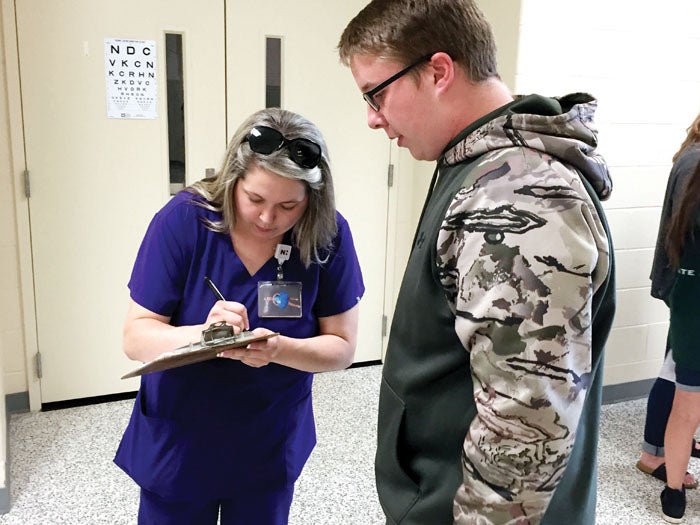School is coming: 30 tips for kicking off a healthy new school year
Published 12:00 am Thursday, August 9, 2018

- Davie County High School football player Paul Pollard received a sports physical earlier this year with Novant Health at the Mocksville school. Pollard will be a junior this year with the War Eagles.
When you’re going through the annual rites of August with and for your children — buying school clothes, finishing the summer reading list and practicing waking up when it’s still dark outside — don’t neglect back-to-school health care needs. Here’s a quick checklist.
Health and wellness
- Back-to-school must-do: Vaccinations. Kids must have certain vaccines before they start school. Know what they need before kindergarten, middle school, high school and college.
- It only hurts for a second. Help prepare your child for getting a shot. And then be sure they gets a flu shot before flu season. Learn more at the U.S. Health and Human Services’ vaccines.gov site.
- Forty winks. Few things are more essential for a good day at school than getting enough sleep the night before.
- What’s a four-letter word associated with school? L-I-C-E. Know how to check your child’s scalp for the parasitic insects and how to treat your child (and your house!) if the critters should take up residence. And don’t forget the super lice.
- After-hours health care. Deciding when to take your child to the emergency room versus an urgent care clinic can be confusing. (Hint: If it’s something you’d normally take your child to the pediatrician for during normal business hours, an urgent care center is likely sufficient.)
- Breathe easy. The conventional wisdom on asthma diagnoses has changed dramatically in recent years. Physicians used to say children under the age of 4 or 5 couldn’t be accurately diagnosed. Now, even infants can be. Know the symptoms.
- You know what they say about all work and no play. Kids need a healthy balance of schoolwork, play and unstructured downtime.
Nutrition
- Limit energy drinks. Those cleverly marketed “energy drinks” are loaded with sugar that can lead to weight gain and tooth decay. Kids and adults need water – and plenty of it.
- The most important meal of the day. Set your kids up for success by beginning their day with breakfast. It doesn’t take much time to offer healthy options your kids will want to eat.
- Power lunch. Pack a healthy lunch your kids will eat — and you’ll feel good about. For ideas, visit choosemyplate.gov.
- Go easy on the OJ. And the apple, cranberry and grape juice. Whole fruit (orange and apple slices, grapes, a banana) is good for you; the added sugar in juice is not. We all need to stay hydrated — but water is the best way to do that.
Sports
- Let’s get physical. The sports physical is the healthiest place to ensure your child is ready to suit up for athletics.
- Are you raising an aspiring Serena Williams? Sports parents play a vital role in how their kids behave on the field or court and how they cope with losing. It’s important kids maintain a healthy outlook on sports.
- Ouch! If kids are going to play sports (and they should), getting hurt goes with the turf. Getting back out on the field or court too soon can lead to further injury and long-term problems. Take it slowly, and follow doctor’s orders.
- Overuse injuries can happen in children, too. Taking one day off a week from a beloved sport and cross-training are among strategies to prevent overuse injuries.
Early childhood
- Tiny tyrants. Parents can make the terrible twos and threes a little less exhausting. Learn a few basics on nutrition, sleep, play and the big one — potty training — from a pediatrician.
- Remain calm. Being “calm and consistent” is a smart strategy for parenting 4- and 5-year-olds.
- It’s elementary. Children aged 6 to 10 are becoming self-sufficient — but this new phase comes with its own new set of worries. Is your child socially well-adjusted? Do they eat right and get enough exercise? Get a pediatrician’s take.
Teens and tweens
- Stuck in the middle. The middle school years can be trying in the extreme. Adolescents are ready for more freedom — but how much? Parents can help their pre-teens successfully navigate this hormone-filled territory by limiting social media, talking about tough subjects and paying close attention.
- Adolescence online. Electronic devices are now inextricably linked to childhood. (And adulthood.) They can help kids stay connected to friends and family — but they can also be used to bully and exclude. Help your tween or teen safely steer his way through the social media minefield. It’s imperative for parents to stay informed and involved.
- Beyond typical ups and downs. Parents need to know the signs of depression in children and offer love and support if their teen exhibits symptoms. Effective treatment includes an innovative “partial hospitalization” program for adolescents and teens.
- The STD/cancer link. The HPV vaccination wasn’t around when most adults were kids. But it’s here now. And it’s an effective safeguard for your kids — boys and girls — against certain types of cancers, including cervical, anal and oral cancers.
- Choosing a provider for your child is a major decision

